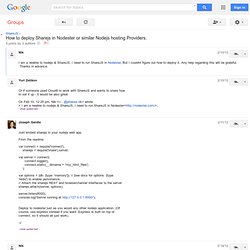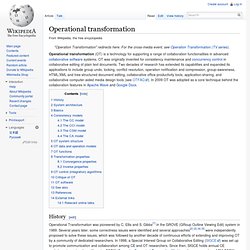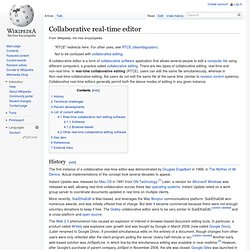

Socket.IO: the cross-browser WebSocket for realtime apps. NowJS and Node.js Tutorial – Creating a multi room chat client. Node.js is a server side environment for Javascript.

NowJS is a framework built on top of Node.js that connects the client side and server side Javascript effortlessly. The core of NowJS functionality lies in the now object.The now object is special because it exists on the server and the client.This means variables you set in the now object are automatically synced between client and server. Also server functions can be directly called on the client and client functions can be called directly from the server.All in realtime. You can have a working HTTP server up and running in Node.JS with just a few lines of code. For example - This little snippet of code will create an HTTP server, listen on port 8080, and send back “Hello World” for every request. Using NowJS, communication between the client and server side is just as simple. Client Side: Fsln12group4. Fsln12group4.files.wordpress.com/2012/07/pecs_dev_slides_korrektur.pdf. Stefpb/pecs-app. Stefpb/pecs.
Tarr11/codeshare. How to deploy Sharejs in Nodester or similar Nodejs hosting Providers. Just embed sharejs in your nodejs web app.

From the readme: var connect = require('connect'), sharejs = require('share').server; var server = connect( connect.logger(), connect.static(__dirname + '/my_html_files') ); server.listen(8000);console.log('Server running at Deploy to nodester just as you would any other nodejs application. . - show quoted text - On Fri, Feb 10, 2012 at 9:25 PM, Nik <n... Nodester · Open Source Node.JS PaaS.
Etherpad Foundation - Live Document Collaboration. Sharejs.org. Examples. Demos.

Lots of demos. *neo glasses* View source on all these demos to see what they're made of. All the demos live in examples in the source tree. Static renderer This example statically renders documents on the server. View 'html' » General Editor This example shows the use of an Ace editor which can edit any ShareJS document. Edit anything » Wiki This example demonstrates using ShareJS to implement a wiki. Explore the wiki » JSON Client API · josephg/ShareJS Wiki. OT for JSON Spec · josephg/ShareJS Wiki. Note: Operation reference moved here OT for JSON allows multiple users to collaborate on arbitrary documents described by JSON.

This document specifies what operations are valid and how those operations behave when multiple users are editing at the same time. If you want to know how to use JSON in ShareJS, see JSON Client API. The document is stored by a plain JSON object. Documents can be passed initial data when they are created - but if not, they default to storing null. Undefined is not a valid value anywhere in a JSON document. The JSON OT code itself is in the share/ottypes project now. (70) ShareJS. Operational transformation. Operational transformation (OT) is a technology for supporting a range of collaboration functionalities in advanced collaborative software systems.

OT was originally invented for consistency maintenance and concurrency control in collaborative editing of plain text documents. Two decades of research has extended its capabilities and expanded its applications to include group undo, locking, conflict resolution, operation notification and compression, group-awareness, HTML/XML and tree-structured document editing, collaborative office productivity tools, application-sharing, and collaborative computer-aided media design tools (see OTFAQ). In 2009 OT was adopted as a core technique behind the collaboration features in Apache Wave and Google Docs.
History[edit] Operational Transformation was pioneered by C. System architecture[edit] Basics[edit] The basic idea of OT can be illustrated by using a simple text editing scenario as follows. Consistency models[edit] The CC model[edit] T(ins( ),ins( and. Collaborative real-time editor. A collaborative editor is a form of collaborative software application that allows several people to edit a computer file using different computers, a practice called collaborative editing.

There are two types of collaborative editing: real-time and non-real-time. In real-time collaborative editing (RTCE), users can edit the same file simultaneously, whereas in Non-real-time collaborative editing, the users do not edit the same file at the same time (similar to revision control systems). Collaborative real-time editors generally permit both the above modes of editing in any given instance. History[edit] The first instance of a collaborative real-time editor was demonstrated by Douglas Engelbart in 1968, in The Mother of All Demos. Instant Update was released for Mac OS in 1991 from ON Technology.[1] Later, a version for Microsoft Windows was released as well, allowing real-time collaboration across these two operating systems.
Technical challenges[edit] Recent developments[edit] Wave - Welcome to Apache Wave (incubating) Wave in a Box login. Seph.